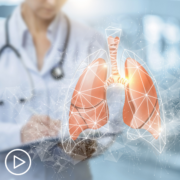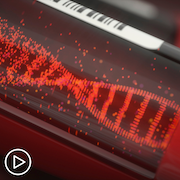How Does Biomarker Testing Impact Non-Small Cell Lung Cancer Care?
How Does Biomarker Testing Impact Non-Small Cell Lung Cancer Care? from Patient Empowerment Network on Vimeo.
Biomarker testing identifies certain genes, proteins, or other molecules present in a biologic sample. Dr. Tejas Patil, of University of Colorado Cancer Center, discusses how results from these tests can be used to determine a treatment approach for non-small cell lung cancer (NSCLC).
Dr. Tejas Patil is an academic thoracic oncologist at the University of Colorado Cancer Center focused on targeted therapies and novel biomarkers in lung cancer. Learn more about Dr. Patil, here.
See More From INSIST! Lung Cancer
Related Resources:

|

|

|
Transcript:
Katherine:
Biomarker testing is important prior to choosing therapy for non-small cell lung cancer. What is this test and how long does it take to get results?
Dr. Patil:
That is a great question. So, a biomarker is a biological molecule found in blood or other body fluids or tissues that is a sign of a normal or an abnormal process.
Or let me reframe that as it represents having some kind of medical condition or disease. Now, it’s a very broad definition. Basically, a biomarker can be used to see how well the body responds to a treatment for a disease or a condition. And when we look at it from a genetic perspective, sometimes the term that you’ll see is a molecular marker or a signature molecule.
So, these are terms that are sort of interchangeable with biomarkers. But the role of a biomarker is to help ascertain how well the body responds to a certain medical intervention, broadly speaking.
Katherine:
Okay. What question should a patient ask their doctor about test results?
Dr. Patil:
So that’s a very complicated question, and I will do my best to answer it succinctly. So, my personal view is that for any test to be meaningful, it should impact medical decision-making in some very concrete way.
Specifically, with biomarkers, the result should either be prognostic or predictive and I’ll define what those terms are. So, a predictive biomarker is one that helps determine if a certain therapy will be effective. So, I’m going to use lung cancer as an example. In EGFR mutation in non-small cell lung cancer allows a doctor to prescribe an EGFR targeted therapy called osimertinib (Tagrisso). Therefore, in this example, the EGFR mutation is predictive.
It opens the door for this targeted option that would otherwise not have been available if the patient did not have this EGFR mutation. A prognostic marker is a little different. This is the type of marker that helps categorize risk. So, in the same example I used earlier, that patient may have an EGFR mutation.
They can also have a different mutation called TP53. Now this TP53 mutation doesn’t influence therapy. It’s not targetable, but it does influence risk.
And so, there’s been a lot of emerging data to show that patients with TP53 mutations have worse outcomes on targeted therapies than patients without TP53. And in that case, that mutation is what we call a prognostic biomarker.












